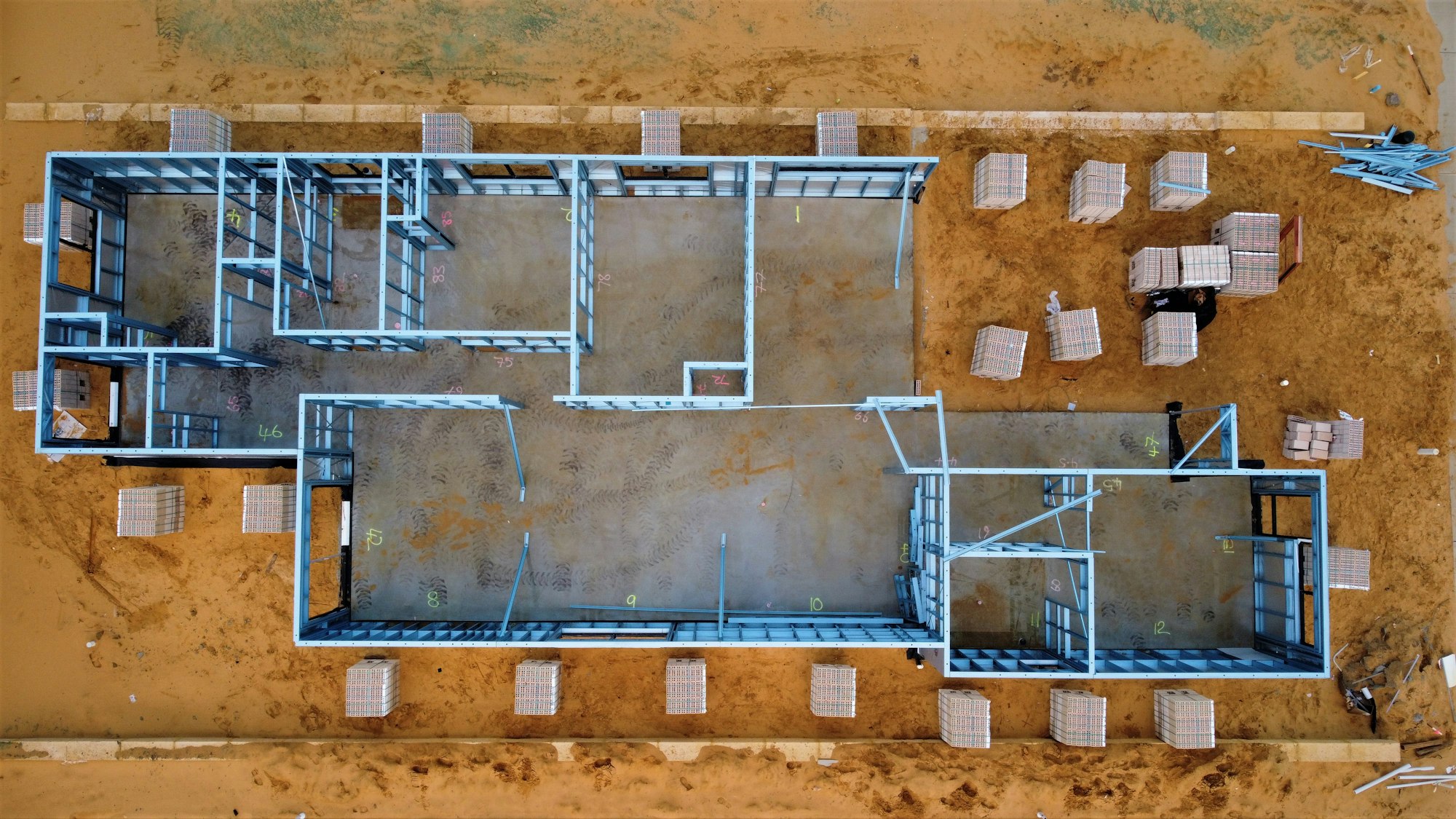You've come to the right place to learn all about residential construction and quality management. Before we forget, if someone forward you this newsletter, don't forget to subscribe to our newsletter to gain access to our resources and the occasional email update.
📣 Factoid Of The Week
The Australian Government’s National Housing Accord sets an aspiration to build one million new homes from mid-2024 (often discussed alongside a broader 1.2 million figure to 2029). Workforce capacity is a known constraint.
Previously, we covered Drum-Buffer-Rope (DBR)—a scheduling approach from Goldratt’s Theory of Constraints where the constraint sets the pace (“drum”), a buffer protects it, and a “rope” controls release of work. Read more here. Read more about this here.
On 31 August 2025, India’s Commerce and Industry Minister Piyush Goyal said India is in “deep negotiations” with Australia on a proposal to help build up to one million homes, including sending Indian workers trained to Australian standards. No binding agreement has been announced; details remain under discussion.
Separately, Canberra has announced incentives to boost local construction apprentices, signalling a twin track: train at home while exploring migration settings.
If industry groups consistently cite shortages and support skilled migration—and India’s minister publicly flags “deep negotiations”—it sounds like Australia will expand or fine-tune pathways for overseas construction workers in some form.
However, until the Australian Government confirms a program (numbers, timing, visas, licensing, supervision), it’s not a done deal.
🤔 Skilled migration, housing—and a better way forward?
It’s a bit of a mystery. We’re thinking of bringing in 180,000 skilled migrants to boost housing supply, yet we already struggle to build properly, with proper oversight and compliance.
Surely there’s a smarter way to use skilled migrants than a quick fix for a much bigger problem: housing as an investment class worth ~$11 trillion—far beyond superannuation at ~$6.4 trillion. We need to change this equation - and fast!
Meanwhile, the Government has money set aside but no houses to show for it. Lots of planning. Lots of talking.
More money + more waiting = fewer houses & more problems.
Time matters. If the plan is to roll out solutions four years from now, we’ve just compounded the problem.
What’s needed isn’t more process for the sake of it—it’s bold, decisive action. Try things, learn fast, and course-correct. The usual “consult everyone, hire a management layer to indemnify the decision, and write a report” won’t cut it.
By the time the consequences arrive, you’ve added new barriers and made the climb back even steeper. So what should we do—beyond improving throughput (which we’ve covered in the post linked in the Factiod Of The Week Section - or here)?
The only way to move the needle at scale is to think and act like a tech company.
👉️ Yes, i'm going to say a phrase I hate—
move fast and break things.
If you’ve read my AI posts, you’ll know I wrestle with the trade-offs in productivity and safety. Both can be true.
A bigger idea: a Sovereign Innovation & Talent Fund
This is about supersizing Australia’s tech industry so we can compete on the world stage—and, in turn, unlock better tools, systems, and delivery models (including for housing).
👉️ Instead of bringing in 180,000 skilled migrants as a band-aid, go bigger: solve this problem and many others at the same time.
Why not go the full monty, not the half monty?
Here’s another way forward:
- Stand up a Sovereign Innovation & Talent Fund. Start with $1 billion and open it to Australian founders building in software, advanced manufacturing, AI, fintech, govtech, contech—everything that moves productivity. Housing is one track, not the whole show.
- Widen the talent funnel—at scale. Alongside 150,000 skilled construction workers, bring in 300,000 computer-science graduates (with industry-ready skills) from India as well. Bring builders and builders-of-systems. If your going to do this, you might as well double down.
- Fast-track deployment. Create streamlined visas, skills recognition, and placement programs that plug CS talent directly into Australian startups, scale-ups, and research spin-outs. Pair with paid internships and graduate residencies.
- Crowd in private capital. Make innovation a compelling alternative to property as a store of wealth. Cap tax-advantaged property holdings (say 1–3 dwellings). Beyond that, tilt incentives so backing new tech ventures is the smarter play.
- Match funding, de-risk early growth. For companies raising private money, match $1:$1 up to a cap. Prioritise firms shipping exportable IP, deep tech, and platform plays that compound.
- University → industry, on purpose. Embed students and researchers into funded companies via co-ops and part-time roles. Turn research into revenue, not published papers for the sake of academia only.
👉️ More minds on the problem beats more press release about the problem. If policy-makers had a working answer, we’d see it by now. Instead, lobby groups keep the volume high and the aperture narrow.
👉️ Also—if the construction industry’s traditional solutions were enough, we wouldn’t be here.
👉️ Setting aside negative gearing, CGT, and income inequality for a moment: why hasn’t the construction sector produced products and processes that genuinely scale quality, speed, and affordability?
Because incumbents optimise for what they know and can control.
The uncomfortable bit
Voters are frustrated. The Government seems to be listening—to the loudest voices closest to their ear (lobbyists, not voters). The Opposition isn’t offering much beyond an own-goal masterclass.
What we need is leadership and problem-solving, not pageantry. Turn down the lobby power. Back Australian ingenuity. Stick your neck out and build pathways that let the country help itself. Give people a real chance to help themselves—not more band-aid solutions.
If you’re serious, grow an alternative asset class—a technology investment fund—that competes with housing as a store of wealth. Redirect capital and talent toward innovation with clear, near-term outcomes (housing included).
That’s how you kick off a virtuous cycle: new firms, new tools, better delivery, and homes people can actually live in. Treat the shifting world order as an opportunity, not a threat. Use it to reposition Australia as a technology and innovation hub.
To our politicians: by all means bring in skilled migrants to help fix housing supply—but do it smartly. Recruit 300,000 Indian computer-science graduates and build a focused tech hub here. Use the success of Atlassian and Canva (among others) to catapult Australia into a place where innovators come to build, not a place they leave.
Stop the brain drain, back the country, and give us a fair shot at the lives we want—not a life of servitude.
Own past mistakes. Acknowledge the problems. We’ll forgive—just don’t deny us the chance to help ourselves. Create the conditions to grow.
We’re only a few steps away from a crypto-based economy. Get ahead of the technology—don’t stay beholden to old mates who now treat us like adversaries. Time is running out and your choices now will impact generations of people!
A bigger tax base alone isn’t a strategy—it’s a hope.
The world is realigning. Use it, or we will all lose!
🤗 Howdy Readers
In this newsletter, you'll find:
📬️ Post 1 - Is There Enough Timber for New Homes? Here’s the real picture 😲
Thinking about building and wondering if Australia actually has enough timber to go around?
In this post we break down why native hardwood supply is shrinking, why softwood plantations (hello, pine frames) carry most of the load, and why that matters for your build timeline and budget.
You’ll read how manufacturing—not logging—is where most of the value (and bottlenecks) sit, and why short-term shortages are pushing us toward more imports.
We also explain the outlook (forest futures report summary): slow plantation growth, long lead times, and how carbon credits and grants could help turn the tide.
👉️ Building soon? Get the facts before you pick your frame — read on.

📬️ Post 2 - PR Isn’t Truth—It’s a Popularity Game (and how to see through it) 🧐
Ever wondered why some brands get wall-to-wall hype while others barely get a mention?
In this post we argue PR’s job isn’t honesty—it’s shaping perception with spin, stunts, and carefully crafted messages (doublespeak anyone?).
You’ll learn the most common tactics (euphemisms, omission, repetition) and when companies crank PR to eleven—launches, rebrands, and crisis control. More importantly, we explain how to spot the tells, so you can judge claims on facts, not fumes. Handy if you’re a homeowner, buyer, or builder trying to separate substance from sizzle. Click to learn more.
👉 See the spin, not just the shine — read on through the bookmark below:

📬️ Post 3 - How to Think Clearly When You Don’t Know What You Don’t Know 🤔
Ever feel like the more you learn, the more you realise you don’t know?
This week’s post breaks down “known knowns,” “known unknowns,” and those sneaky “unknown unknowns,” from ancient Persia to Rumsfeld—and why they still matter today.
You’ll learn how naming uncertainty actually helps you make better decisions, manage risk, and avoid overconfidence. We also discuss simple ways to turn surprises into learning, not setbacks. Perfect if you’re juggling projects, planning a build, or just trying to think clearer.
👉 Spot your blind spots—click the bookmark below to learn more.

🔒 Software of the Week: VP.NET (Verified Privacy VPN)
(This isn’t a sponsored post—just software we recently came across and thought we’d share it with you.)
Yes, this is a VPN but its a bit different to the normal VPNs being flogged to you through social media &Youtube.
What it is: VP.NET is a new VPN that routes your internet traffic through hardware “secure enclaves” (Intel SGX). In regular person speak: the company says it can’t see or log what you do online—even if it wanted to—because your identity and traffic are separated inside a locked box the provider can’t open.
Why it matters: Most VPNs ask you to trust “no-logs” promises. VP.NET changes that to “don’t trust—verify,” aiming to make privacy verifiable by design, not marketing. It’s available on Windows, macOS, Linux, iOS and Android.
Features → Benefits
- Zero-knowledge architecture: Your real IP and your browsing are kept apart in a hardware vault → less risk that anyone (including the VPN) links activity back to you.
- Open approach & audits discourse: Tech outlets have reported on the “cryptographically verifiable privacy” angle; some note SGX has a history of patched vulnerabilities—which is useful context if you like to kick the tyres.
- Modern VPN staples: WireGuard, kill switch, DNS protection→ fast, safer-by-default everyday browsing.
Who it’s for: Privacy-first users, journalists, travellers, and anyone who wants a VPN that minimises “just trust us.”
If you’re comparing options, note that rivals like IVPN and NYM pitch strong privacy too—at different price points and with different designs (e.g., decentralised mixnet).
Systems & pricing: Apps for all major platforms. Pricing and terms change (intro vs renewal rates vary widely across the industry), so check the current VP.NET page before you subscribe.
Why we like it: A fresh, verifiable spin on “no-logs,” founded by the creator of Private Internet Access—ambitious tech with a clear thesis: don’t trust; prove.
👉 Curious if verifiable privacy fits your setup? Click the bookmark below check it out for yourself
VP.NET was launched around 4 months ago (September 2025 originally published this post)
📰 Interesting News Articles From This Week

🛍️ Ad Of The Week
"Your Not You When Your Hungry" - Snickers Ad
Can't see the video embed below? Click here. to watch on Youtube.
🎧️ Music of the week
"Everybody Wants To Rule The World" - Tears For Fears (1985)
Im pretty sure this song was featured before, oh well, its a great song!
Can't see the video embed below? Click here. to watch on Youtube.
✅ Our Quality Checklists

C14 Tile Design & Installation Checklist recently added to the list 09-08-2025
Please note: You’ll need to be a member and to log in to access the content.
📜 Reader Survey: Should all builders display a quality rating score?
Tell us what you think. Can't see the embed below? Click here to open it (opens builder quality score rating survey)












